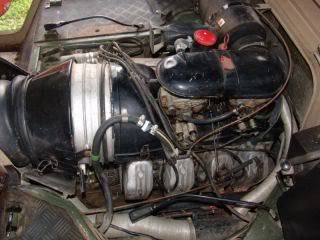Page 1 of 1
does anybody else have this intake shroud?
Posted: Fri May 22, 2009 2:39 am
by norcal pinz
It seems like this shroud would make the fan not as loud in the cab and help cool the engine better what do you guys think? i got the photo from e bay its a civilian model.

Posted: Fri May 22, 2009 10:53 am
by cronapress
I had a civi. 710M prior to the military 712M. There wasn't any front shroud, or signs of fitting thereof at all.
I can't find any sign of one in the Parts Manual.
In theory, it should force more air via the fan intake. Maybe an option in warmer climbs only ??
If it's a home-made jobbie, it's nicely done.
Posted: Fri May 22, 2009 11:42 pm
by russ
I like the look of it. I also see it has the same slipping large o'ring issue as mine.

It needs a snorkel.
Posted: Sat May 23, 2009 2:33 am
by Profpinz
I've seen that shroud used on a few vehicles around the world (including one that I saw here in Australia back in the early 80's) but I've never found reference to an official part number in any of the parts manuals etc that I have.
I did however contact a guy who used to work at Haflinger Sales and Service/Pinzgauer Enterprises here in Melbourne, assembling the Pinny's back in the 70-80's, and he did seem to remember that my Pinzgauer (the first Pinzgauer imported into Australia in 1974) did have a unit as discussed originally fitted....it didn't when I brought it in the 80's.
Given the above I'd be interested to know if the picture posted was of an early motor ....in other words has the crankcase got side ribbing or is it plain/smooth?
Early motors were plain, later crankcases were externally ribbed.
"Maybe" such an arrangement was only added to early units.
Posted: Sat May 23, 2009 9:30 am
by Erik712m
Profpinz wrote:I've seen that shroud used on a few vehicles around the world (including one that I saw here in Australia back in the early 80's) but I've never found reference to an official part number in any of the parts manuals etc that I have.
I did however contact a guy who used to work at Haflinger Sales and Service/Pinzgauer Enterprises here in Melbourne, assembling the Pinny's back in the 70-80's, and he did seem to remember that my Pinzgauer (the first Pinzgauer imported into Australia in 1974) did have a unit as discussed originally fitted....it didn't when I brought it in the 80's.
Given the above I'd be interested to know if the picture posted was of an early motor ....In other words has the crankcase got side ribbing or is it plain/smooth?
Early motors were plain, later crankcases were externally ribbed.
"Maybe" such an arrangement was only added to early units.
Probably should not disagree but if was only on the earlier motors? Why is it on the 715E?
http://www.sdp-pinzgauer.org/pinz-archi ... pdate.html
I thought I read some were it was an option based on climate There is a damper in line.
Posted: Sat May 23, 2009 5:53 pm
by Profpinz
Probably should not disagree but if was only on the earlier motors? Why is it on the 715E?
Good point Erik, and yes that does kill my theory that it may have only been used on earlier motors!


Your probably right that it was a "climate" thing.
Thanks Brian....that's an interesting vehicle.
Given the above, it appears that it was a factory option recommended for certain operating environments and that it was most likely available over the whole time the air-cooled range was produced.
Posted: Sat May 23, 2009 7:16 pm
by The true Pinzgauer´s
The Air-intake parts are prototypes parts from factory. It was mount to get more cooling and cooler air at the cylinder´s. It was not often build only for special vehicles like 2.7 engine, fuel-injection and charger engines. It is a little bit smouther ,but the weak-point is the hotter engine room ( because the air-flow from tunnel gets only through the engine) , so the carburators and the ignition faults of overheating, and there where a hotter air-intake for the engine( hot air is not good to compress- less horsepower) .Also little stones kills more oil-radiators, because they was really sucking in.
There was also a tube under the air conduit for a cooler, oil and petrol smell-free air, for air-inlet of the heater. It started right behind the fan and goes direct to the air-outlet of the rear engine-air-conduit

